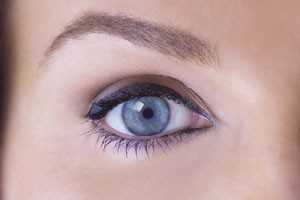 Throughout life, our eyes sometimes become dryer. We need tears for good vision, good eye comfort, and to maintain the health of our eyes.
Throughout life, our eyes sometimes become dryer. We need tears for good vision, good eye comfort, and to maintain the health of our eyes.
Tears are evenly spread across the corneas with each blink. They reduce friction through lubrication, they wash away most of the dust and dirt that gets in the eyes and they actually contain a bacteria fighting enzyme.
Dryness can result in a few of ways: not enough tears are being produced, the tears are evaporating too quickly, tears aren’t spread evenly across the eyes, and tears are leaving to eyes too quickly.
Tears are made by several sets of glands: The Goblet cells produce mucin which is the bottom layer of the tears. This thick mucin fills in all the hills and valleys of the corneas to make a flat surface for the next layer. The Lacrimal, Krauss and Wolfring glands make the middle water layer. This is the majority of the tear layer. The Meibomian, Zeiss and Moll glands produce the oil layer at the top of the tears. This oil covers the tears so they won’t evaporate so readily into the atmosphere.
As we get older, all three layers can be affected by inflammation, changes in hormone levels, side effects from several medications and environmental factors. There is a very specific equilibrium for tears and if any of these are reduced or missing, the tear quality suffers.
Dry eye symptoms include irritation, grittiness, blurred vision and even excess watering. You may wonder why your eyes are watering if they’re supposedly dry… Think of it this way: There’s two types of tears: 1) reflex tears. These occur when your eyes are irritated like when an onion is being cut. 2) basal tears. These are the normal, thicker, multi-layered tears. Dry eyes have lower levels of basal tears creating friction and irritation. This sets off the reflex tears. The brain thinks that something is in your eyes and is trying to wash it out.
What causes dry eyes?
The development of dry eyes can have many causes. They include age, gender, medications, medical conditions and previous trauma or surgery. Eyes can become dry due to reduced hormones, antihistamines, decongestants, anti-depressants, blood pressure medicines, etc. Medical conditions like thyroid problems, arthritis, diabetes and auto-immune diseases can cause inflammation of the tear glands leading to less tear production. Previous surgeries to the eyes like LASIK can lead to temporary dryer eyes until the cut corneal nerves regenerate. The lid oil glands can become clogged with age or extended contact lens use.
How are dry eyes diagnosed?
Dry eyes can be diagnosed in an eye exam with the patient history, microscopic findings of the eyes and lids, tear production testing, and tear quality testing with our Tear Lab® system.
How are dry eyes treated?
Dry eyes can be treated in many ways depending on the root cause or causes. Treatments include warm compresses to the eyelids to alleviate clogged oil glands, the use of low dose oral antibiotics to liquefy solidified oils in the lid oil glands, artificial tears, little silicone plugs for the tear drainage holes in the eyelids, medications like Restasis or Xiidra that alleviate tear gland inflammation, and Fish Oil or Omega 3 pills that also reduce inflammation. Dry eyes are a chronic condition, but we can prescribe treatment to keep your eyes healthy, more comfortable, and prevent your vision from being affected.
